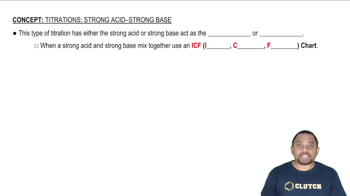A 30.0-mL sample of 0.165 M propanoic acid is titrated with 0.300 M KOH. Calculate the pH at each volume of added base: 10 mL.
Ch.18 - Aqueous Ionic Equilibrium
Chapter 18, Problem 78f
A 30.0-mL sample of 0.165 M propanoic acid is titrated with 0.300 M KOH. Calculate the pH at each volume of added base: 20 mL.
 Verified step by step guidance
Verified step by step guidance1
Identify the initial moles of propanoic acid (CH₃CH₂COOH) using its concentration and volume: \( \text{moles of CH₃CH₂COOH} = 0.165 \text{ M} \times 0.030 \text{ L} \).
Calculate the moles of KOH added using its concentration and the given volume: \( \text{moles of KOH} = 0.300 \text{ M} \times 0.020 \text{ L} \).
Determine the limiting reactant by comparing the moles of KOH and propanoic acid. Since KOH is a strong base, it will react completely with the propanoic acid.
Calculate the moles of propanoic acid remaining after the reaction with KOH, and determine the moles of propanoate ion (CH₃CH₂COO⁻) formed.
Use the Henderson-Hasselbalch equation to find the pH: \( \text{pH} = \text{pK}_a + \log \left( \frac{[\text{CH}_3\text{CH}_2\text{COO}^-]}{[\text{CH}_3\text{CH}_2\text{COOH}]} \right) \), where \( \text{pK}_a \) is the negative logarithm of the acid dissociation constant of propanoic acid.

Verified video answer for a similar problem:
This video solution was recommended by our tutors as helpful for the problem above.
Video duration:
6mWas this helpful?
Key Concepts
Here are the essential concepts you must grasp in order to answer the question correctly.
Acid-Base Titration
An acid-base titration is a quantitative analytical method used to determine the concentration of an acid or base in a solution. In this process, a solution of known concentration (the titrant) is added to a solution of unknown concentration until the reaction reaches its equivalence point, where the amount of acid equals the amount of base. The pH changes during the titration, and understanding this change is crucial for calculating the pH at specific volumes of titrant added.
Recommended video:
Guided course

Acid-Base Titration
Weak Acid and Strong Base Reaction
In this titration, propanoic acid acts as a weak acid, while KOH is a strong base. When a weak acid is titrated with a strong base, the pH at the equivalence point will be greater than 7 due to the formation of the conjugate base of the weak acid. The pH before the equivalence point can be calculated using the Henderson-Hasselbalch equation, which relates the pH of a buffer solution to the concentration of the acid and its conjugate base.
Recommended video:
Guided course

Strong Acid-Strong Base Titration
Henderson-Hasselbalch Equation
The Henderson-Hasselbalch equation is a formula used to calculate the pH of a buffer solution. It is expressed as pH = pKa + log([A-]/[HA]), where pKa is the negative logarithm of the acid dissociation constant, [A-] is the concentration of the conjugate base, and [HA] is the concentration of the weak acid. This equation is particularly useful in titration problems to determine the pH at various points before reaching the equivalence point, especially when dealing with weak acids.
Recommended video:
Guided course

Henderson-Hasselbalch Equation
Related Practice
Textbook Question
Textbook Question
A 30.0-mL sample of 0.165 M propanoic acid is titrated with 0.300 M KOH. Calculate the pH at each volume of added base: equivalence point.
Textbook Question
A 30.0-mL sample of 0.165 M propanoic acid is titrated with 0.300 M KOH. Calculate the pH at each volume of added base: one-half equivalence point.
Textbook Question
A 30.0-mL sample of 0.165 M propanoic acid is titrated with 0.300 M KOH. Calculate the pH at each volume of added base: 25 mL.
Textbook Question
Consider the titration of a 25.0-mL sample of 0.175 M CH3NH2 with 0.150 M HBr. Determine each quantity. a. the initial pH
Textbook Question
Consider the titration of a 25.0-mL sample of 0.175 M CH3NH2 with 0.150 M HBr. Determine each quantity. c. the pH at 5.0 mL of added acid
1
views
